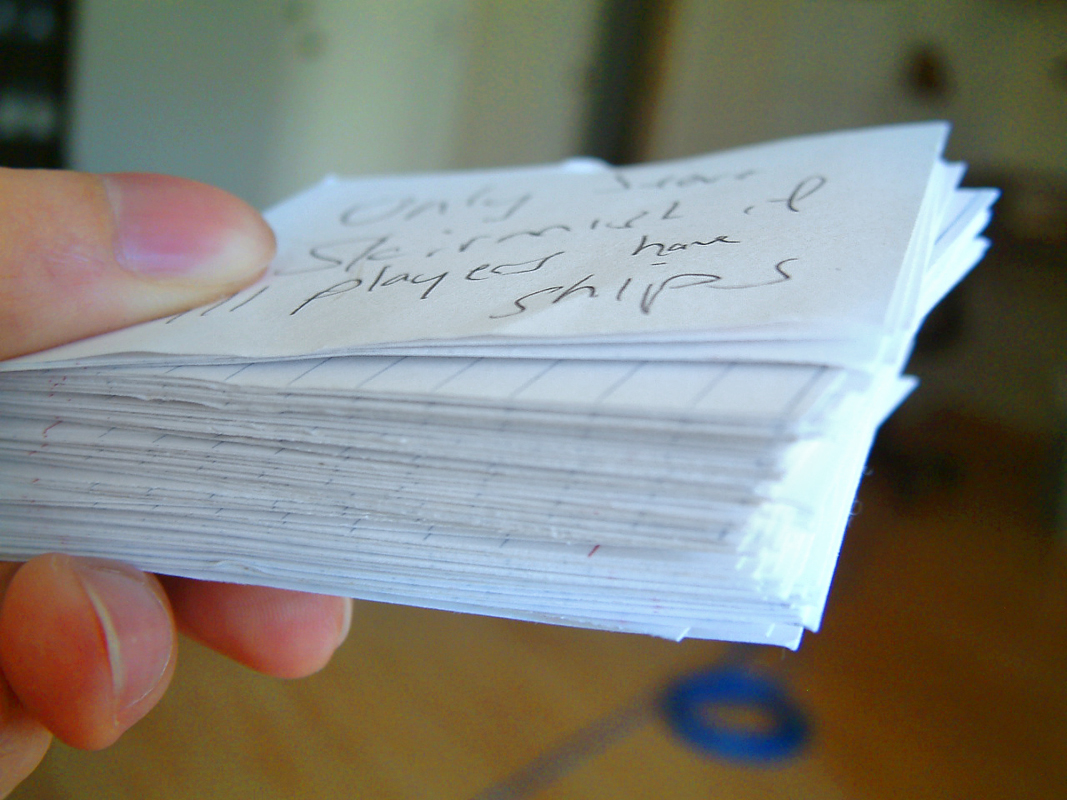Card Shark
Atom Zombie Smasher was recently released on Steam. As a result of that, my backlog of feature requests and bug reports has shot up by a bajoolion percent. I thought I’d take a minute to breathe and talk about how I handled task management.
This picture shows the ancient technique used on Flotilla and Air Forte: index cards and a pink tissue box.
What powers this infernal machine? Here’s how it works:
When I think of a new task or notice a bug, I write it on an index card. Example: “Make walk animation.”
The card is placed next to its friends on my heater.
When I need something to do, I take a look and decide which card to tackle.
When I complete the task, I toss it into the tissue box.
That’s it. You might be thinking, “Wait a minute! That’s nothing more than a to-do list. I’ve been hoodwinked!” To which I answer: you’re not that far off. Though, I did end up ultimately preferring the index cards over a traditional list, for reasons I’ll get into later.
For reference’s sake, here’s the size of the final deck from Flotilla:
For those playing at home: the top card reads, “Only start skirmish if all players have ships.” At some point, Flotilla had a bug where a player could start a skirmish battle with no ships in his fleet. This resulted in extremely brief battles.
(For Lean and Agile development fans: if you squint really, really, really hard, you’ll find this was all very loosely inspired by the Kanban board technique, which we used to great effect at Pandemic. If you have a medium-to-big team, do investigate it.)
The Age of Notepad.exe
For Atom Zombie Smasher, I decided to go a different direction and used notepad.exe to keep track of all my tasks. Here’s how that text file ended up: click here to read it
I wrote tasks down, and when I completed them I appended “XXXXXX” in front of them; the equivalent of throwing them into the tissue box. I assumed it would be a 21st century digital version of my index cards. But I felt it didn’t work out nearly as well.
For one, just take a look at the file. It looks like someone barfed out letter soup. There are code snippets, crash logs, half-baked sentences. I fell prey to using this file as a junk drawer.
On Analog
Something has to be said about analog vs. digital. I was fortunate to have once edited a film project on a musty old Moviola flatbed machine. By this time, digital editing was the norm, so getting to use this ancient analog metal beast was a rare treat.

The room smelled like wet dog and sawdust. Absolutely everything was time-consuming. And I loved it. I loved splicing the film and threading it through the tiny wheels. What I loved most was that it forced you to think about every decision. Are you sure you want to make that cut? Making a splice takes time. I think what you really want is to move the cut there instead.
That cut was probably also a wrong decision, but damn did it force you learn the hard way. You had to make sure something was worth your time.
That thoughtfulness was what my .txt file lacked. It was too effortless to throw random crap into it. As a result, its signal to noise ratio was terrible. When I needed to find a new task, I had to wade through a lot of things that honestly shouldn’t even be there. Granted, this is probably just my own shortcoming; I’m sure you’ll fare much better!
Distinguishing features I liked about having index cards:
It’s a physical object. When the index cards start snaking their way across my living room floor, I immediately know something has gone awry.
I find it easier to visualize the relationship between all the cards - dependencies, importance, etc. It encourages you to touch ‘em & move ‘em around.
It’s surprisingly effective at rooting out the stupid. Taking the time to uncap a pen and write on a card requires just enough commitment to block out most half-baked ideas.
And really - the ritual of throwing a completed index card into a pink tissue box is way more satisfying than it should be.

